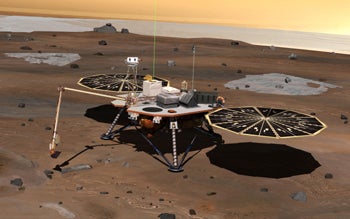After a nearly 10-month journey, the Phoenix lander will touch down on Mars May 25. Confirmation of the landing could come as early as 7:53 P.M. EST. The descent and landing will be a nail-biter for mission controllers. The lander must slow from a speed of 13,000 miles per hour (20,900 kilometers per hour) to 5 miles per hour (8 kilometers per hour) in 7 minutes. The 904-pound (410 kilograms) craft will use rocket engines for the final 25 seconds of its descent after braking at higher altitude with parachutes. (View an animation of the landing here.) In more recent missions, like the Spirit and Opportunity rovers in 2003, airbags provided cushioning for the final landing.
Launched August 4, 2007, Phoenix is the first in NASA’s Scout Program, which aims to conduct smaller, low-cost science missions. The craft’s onboard laboratory will study the history of water and habitability potential in the martian arctic’s ice-rich soils.
“Our landing area has the largest concentration of ice on Mars outside of the polar caps,” said the mission’s principal investigator, Peter Smith, of the University of Arizona, Tucson. “If you want to search for a habitable zone in the arctic permafrost, then this is the place to go.”
Phoenix carries hardware from two unsuccessful missions: the Mars Polar Lander and the Mars Surveyor 2001 Lander. The Polar Lander crashed on Mars. Mars Surveyor was built but never launched.
Cold, arid Mars lacks standing water on its surface. But in the arctic regions, copious ice lies right below the surface. In 2002, the Mars Odyssey Orbiter located large amounts of subsurface water ice in the northern arctic plain.
Phoenix will visit this ice-rich area. Its robotic arm will dig through the protective topsoil layer to the water ice below. Then it will carry a sample of soil and ice to the lander’s various onboard scientific instruments for study.
Phoenix’s planned mission period is 92 Earth days. After that, the martian winter will settle over the craft. The waning light will deprive the solar-powered laboratory of electricity to run its instruments. Mission planners expect the lander to end its life covered in frozen carbon dioxide gas (dry ice). Chances are remote that Phoenix will hum back to life in spring.
The mission takes its name from the mythical phoenix bird that symbolizes rebirth. When the bird dies, it bursts into flames. A new bird then rises from the ashes of the pyre.
arose on Mars
Continuing the Viking missions’ quest, but in an environment known to be water-rich, Phoenix will search for signs of life at the soil-ice interface just below the martian surface. Phoenix will land in the arctic plains, where its robotic arm will dig through the dry soil to reach the ice layer, bring soil and ice samples to the lander platform, and analyze these samples using advanced scientific instruments. These samples may hold the key to understanding whether the martian arctic is a habitable zone where microbes could grow and reproduce during moist conditions.
Characterize the climate of Mars
Phoenix will land during the retreat of the martian polar cap, when cold soil is first exposed to sunlight after a long winter. The interaction between the ground surface and the martian atmosphere that occurs at this time is critical to understanding the present and past climate of Mars. To gather data about this interaction and other surface meteorological conditions, Phoenix will provide the first weather station in the martian polar region — no others are currently planned. Data from this station will have a significant impact on improving global climate models of Mars.
Characterize the geology of Mars
As on Earth, the past history of water on Mars is written below the surface. Phoenix will use a suite of experiments to thoroughly analyze soil chemistry and mineralogy. Some scientists speculate the landing site for Phoenix may have been a deep ocean in the planet’s distant past leaving evidence of sedimentation. If fine sediments of mud and silt are found at the site, this may support the hypothesis of an ancient ocean. Alternatively, coarse sediments of sand might indicate past flowing water, especially if these grains are rounded and well-sorted. Using the first true microscope on Mars, Phoenix will examine the structure of these grains to better answer questions about water’s influence on the planet’s geology.
Prepare for human exploration
Phoenix will provide evidence of water ice and assess soil chemistry in the martian arctic. Water will be a critical resource to future human explorers, and Phoenix may provide appreciable information on how water may be acquired on Mars. Scientists study the soil chemistry to build an understanding of the potential resources available for human explorers to the northern plains.










